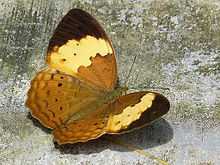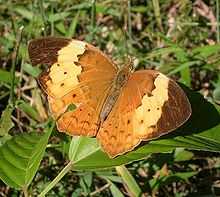Cupha erymanthis
| Rustic | |
|---|---|
 | |
| Typical individual, Kerala | |
| Conservation status | |
| Not evaluated (IUCN 2.3) | |
| Scientific classification | |
| Kingdom: | Animalia |
| Phylum: | Arthropoda |
| Class: | Insecta |
| Order: | Lepidoptera |
| Family: | Nymphalidae |
| Tribe: | Vagrantini |
| Genus: | Cupha |
| Species: | C. erymanthis |
| Binomial name | |
| Cupha erymanthis | |
| Synonyms | |
|
Cupha placida | |
The rustic (Cupha erymanthis) is a species of brush-footed butterfly found in forested areas of tropical South Asia and Southeast Asia.
Description[1]
The upper side of the butterfly is ochraceous light brown. Its fore wing displays some loop-like, slender, dark cellular markings with a broad, somewhat curved, transverse yellow discal band from costa to vein 1, not reaching the termen, broadening posteriorly. The margins are irregularly sinuous, with the inner defined broadly with black, and produced outwards in interspaces 3 and 4. Below this, the margin is squarely indented inwards in interspace 2 and outwardly convex in interspace 1; a curved series of three black spots, the lowest the largest, in interspaces 1, 2 and 3; apical area beyond the band black, with a conspicuous yellow subapical spot in interspace 5, and a paler ill-defined similar spot above it in interspace 6. Posteriorly, the black area is produced narrowly to the tornus and encircles a yellow spot near apex of interspace 2.
The hind wing features a transverse sinuous and very slender black line, followed by a slender and somewhat lunular line, a transverse discal series of five black spots in interspaces 2 to 6, a postdiscal medially disjointed series or broad black lunules, a subterminal series of similar but straighter lunules, and a narrow terminal black band. The outer subbasal transverse line broadens at the costa, and is outwardly margined by pale spots in the interspaces. These are anteriorly white and well defined, and posteriorly obscure or often absent.
The underside of the wing is much paler. The discal band on the fore wing is pale, and the black lunules on the apical area are replaced by pale brownish ochre. There are some obscure marking in the cells of both the fore and hind wings. The males and females are identical. In many places we can find that the butterfly is known as C. e. lotis, but this name has been synonymised with the nominated subspecies. It's wingspan ranges from 45-55 mm.
Markings on the forewing are a discal, transverse, slender, chestnut-brown lunular line, bent inwards above vein 5, and bordered outwardly by a series of dark spots. The large black spot in interspace 1 as on the upperside, and an inner and an outer transverse subterminal series of small dentate spots.
On the hind wing we can see indistinct cellular markings. The outer subbasal dark transverse line as on the upper side, but more clearly defined, very sinuous; a transverse discal series of uneven lunules, paler than the ground color, followed by a series of dark spots, a postdiscal very obscure pale lunular band, and a subterminal series of dentate dark spots, often obscure or obsolescent.
The antennae, head, thorax and abdomen are ochraceous brown. Beneath, the palpi, thorax and abdomen are a very pale ochraceous white.
The caterpillar is brown, with a dorsal and a lateral series of darker brown markings. The head has two slender branched spines, with succeeding segments on each side which feature a lateral series of semitransparent similar brown spines. The pupa is green, studded with eight slender pink filaments and four small pink tubercles.
Subspecies and variants
Var. nicobarica Felder: This subspecies generally (but not always) has the interspace between the postdiscal and sub-terminal transverse series of lunules on the upperside of the hind wing paler than the ground-color of the wings.
Subspecies andamanica Moore: The upperside ground-colour for this subspecies is a very dark ochraceous brown, much darker than in erymanthis generally; markings on both upper and under sides are similar, but on the upper side the spots on the discal band on the fore wing are larger, especially the lowest spot; on the hind wing the upper three spots of the discal series are conspicuously larger; on the underside the ground colour is darker and the markings more clearly defined than in the typical form.
Subspecies placida, of southern India (earlier considered as a full species): The upper side in this subspecies differs as follows: On the fore wing the discal band is distinctly darker yellow, with its inner and outer margins much less sinuous and irregular and the black line defining the inner margin more slender; the spots on the band in interspaces 1,2 and 3 are much smaller, especially the spot in interspace 1, which is no larger than the others and is diffuse and ill-defined; the subapical yellow spots on the black area are usually absent or, if present, are diffuse and indistinct. On the hind wing the outer subbasal line with its outer border of pale spots is generally more clearly defined than in erymanthis. Both fore and hind wings are shaded at the base with olivaceous brown. Markings on the underside are similar to those in erymanthis but more heavily defined.
Subspecies in India:
(1) Cupha erymanthis maja Fruhstorfer, 1898 – Sahyadri Rustic (2) Cupha erymanthis lotis Sulzer, 1776 – Himalayan Rustic (3) Cupha erymanthis andamanica Moore, 1900 – Andaman Rustic (4) Cupha erymanthis nicobarica Felder, 1862 – Nicobar Rustic
Ecology
Caterpillars feed mainly on Flacourtiaceae species, e.g. Flacourtia montana, F. ramontchii, F. rukam, Xylosma racemosa and Scolopia spp.. they also eat plants like Glochidion eriocarpum and Lepisanthes rubiginosum.[2]
Adult butterflies occasionally visit carrion to drink the liquids emanating therefrom. They seem to favor carcasses lying in exposed, sunny areas over those which are in the shade.[3]
-

Upper side
-
_in_Talakona_forest%2C_AP_W_IMG_8208.jpg)
in Talakona forest, in Chittoor District of Andhra Pradesh, India.
-

Male Rustics puddling
-
_in_Talakona_forest%2C_AP_W_IMG_8212.jpg)
in Talakona forest, in Chittoor District of Andhra Pradesh, India.
-

Individual with white forewing patch.
Talakaveri, Kodagu (Coorg) district
Footnotes
References
- Bingham, C. T. (1905): The Fauna of British India, Including Ceylon and Burma. Lepidoptera, Volume 1.
- Hamer, K.C.; Hill, J.K.; Benedick, S.; Mustaffa, N.; Chey, V.K. & Maryati, M. (2006): Diversity and ecology of carrion- and fruit-feeding butterflies in Bornean rain forest. Journal of Tropical Ecology 22: 25–33. doi:10.1017/S0266467405002750 (HTML abstract)
- Robinson, Gaden, S.; Ackery, Phillip R.; Kitching, Ian J.; Beccaloni, George W. & Hernández, Luis M. (2007): HOSTS - a Database of the World's Lepidopteran Hostplants. Accessed July 2007.
[[Category:Butterflies of Singapore ]